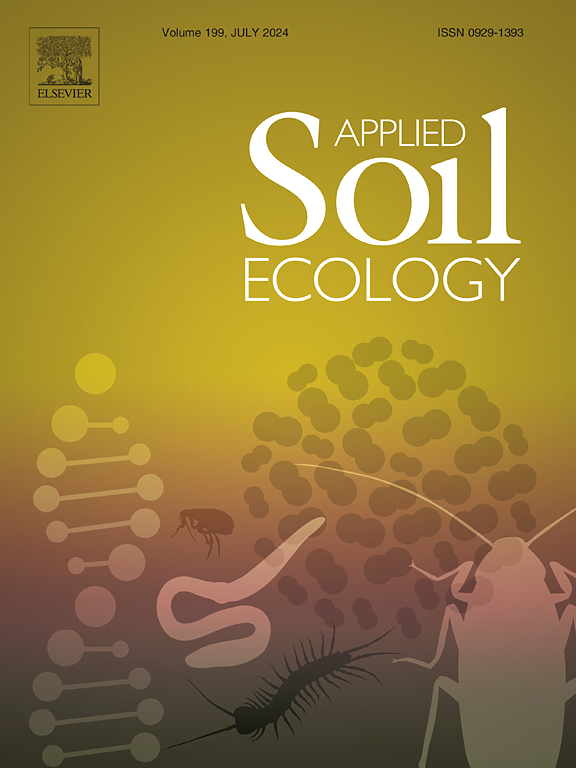Regulation of soil phosphorus availability in alpine meadows: Insights from phosphate-mobilising bacteria
IF 4.8
2区 农林科学
Q1 SOIL SCIENCE
引用次数: 0
Abstract
The populations, activity, and community of phosphate-mobilising bacteria (PMB) affect phosphorus (P) availability via the solubilisation of PMB metabolites in grassland soils. However, PMB variations and their regulation mechanism on soil P availability across degraded meadows are not fully understood. We conducted the dynamic of bioavailable P, phosphatase activity, and PMB properties using field positioning monitoring, quantitative PCR, and high-throughput sequencing technology across different degraded meadow soils in the Zoige Basin, China. Compared with the non-degraded meadow (NDM), the content of soil Olsen and resin P in degraded meadows decreased by 14.7–58.1 % and 34.8–60.1 % respectively, and the abundance of soil PMB with the phoD and pqqC genes declined by 5.6–75.6 % and 6.5–77.4 %, respectively, at most plant growing seasons. In general, soil phosphatase activity in degraded meadows was lower than that in the NDM, while meadow degradation enhanced the diversity of soil PMB. Decreases in the content water and nutrient altered the PMB community composition in degraded meadow soils, which commonly showed that the relative abundance of copiotrophic PMB (e.g. Burkholderiacea with the pqqC gene) decreased, whereas that of oligotrophic PMB (e.g. Bradyrhizobiaceae with the phoD gene) increased. The lower soil bioavailable P was mainly driven by a decrease in the abundance of organic PMB and phosphatase activity under meadow degradation. These results provide new insights into the regulation of soil P availability through stimulating PMB mineralisation on organic P compounds to restore degraded meadows.

高山草甸土壤磷供应的调节:磷酸盐移动细菌的启示
磷酸盐移动细菌(PMB)的种群、活性和群落通过对草地土壤中磷酸盐移动细菌代谢产物的溶解作用影响磷(P)的供应。然而,人们对 PMB 在退化草地上的变化及其对土壤磷供应的调节机制还不完全了解。我们利用野外定位监测、定量 PCR 和高通量测序技术,对中国卓资盆地不同退化草甸土壤的生物可利用磷、磷酸酶活性和 PMB 特性进行了动态研究。与未退化草甸(NDM)相比,退化草甸土壤奥尔森磷和树脂磷含量在大多数植物生长季节分别下降了14.7-58.1%和34.8-60.1%,土壤PMB中phoD和pqqC基因的丰度分别下降了5.6-75.6%和6.5-77.4%。一般来说,退化草地的土壤磷酸酶活性低于非退化草地,而草地退化提高了土壤 PMB 的多样性。水分和养分含量的减少改变了退化草甸土壤中 PMB 群落的组成,通常表现为共养型 PMB(如带有 pqqC 基因的伯克霍尔德菌科)的相对丰度降低,而寡养型 PMB(如带有 phoD 基因的裸根菌科)的相对丰度增加。土壤生物可利用钾降低的主要原因是草甸降解过程中有机 PMB 丰度和磷酸酶活性的降低。这些结果为通过刺激有机钾化合物的 PMB 矿化来恢复退化草地,从而调节土壤钾的可用性提供了新的见解。
本文章由计算机程序翻译,如有差异,请以英文原文为准。
求助全文
约1分钟内获得全文
求助全文
来源期刊

Applied Soil Ecology
农林科学-土壤科学
CiteScore
9.70
自引率
4.20%
发文量
363
审稿时长
5.3 months
期刊介绍:
Applied Soil Ecology addresses the role of soil organisms and their interactions in relation to: sustainability and productivity, nutrient cycling and other soil processes, the maintenance of soil functions, the impact of human activities on soil ecosystems and bio(techno)logical control of soil-inhabiting pests, diseases and weeds.
 求助内容:
求助内容: 应助结果提醒方式:
应助结果提醒方式:


